Crop Health Assessment from Predicted AGB and NPK Derived from UAV Spectral Indices and Machine Learning Techniques
Abstract
1. Introduction
2. Study Area and Methodology
2.1. Study Area
2.2. Methodology
2.2.1. Data Collection
UAV Data Collection
Field Data Collection
2.2.2. Data Pre-Processing
2.2.3. Data Processing
Vegetation Indices
AGB and NPK Estimation
2.2.4. Data Analysis and Validation
AGB and NPK Prediction Using ML Algorithms
Validation Metrics for Prediction Models
Crop Health Assessment
Validation Metrics for Crop Health Assessment
3. Results
3.1. UAV Vegetation Indices
3.2. Temporal Variation in Measured Crop Parameters
3.3. Correlation Analysis Between Vegetation Indices, AGB, and NPK
3.4. Prediction of AGB and NPK Using ML
3.5. Validation Metrics of Predicted AGB and NPK
3.6. Crop Health Assessment
4. Discussion
4.1. Prediction of AGB and NPK
4.2. Crop Health Assessment
5. Conclusions
- UAV-derived VIs effectively captured spatial and temporal variability in crop health and nutrient status across multiple growth stages.
- RF and XGBoost outperformed other models by achieving higher R2 values and lower RMSE for the prediction of AGB and NPK.
- A comprehensive decision-making framework was developed to classify the crop’s health condition into eight categories using 54 AGB and NPK combinations.
- The generated crop health maps, based on predicted AGB and NPK values, demonstrated high classification accuracy when validated against field observations using the same decision framework.
- The proposed integration of UAV imagery, machine learning, and rule-based decision making presents a robust, scalable, and innovative approach to crop health monitoring, supporting timely, site-specific interventions and promoting sustainable agriculture.
Supplementary Materials
Author Contributions
Funding
Data Availability Statement
Acknowledgments
Conflicts of Interest
Abbreviations
| UAV | Unmanned Aerial vehicle |
| AGB | Above-Ground Biomass |
| N | Nitrogen |
| P | Phosphorous |
| K | Potassium |
| ML | Machine Learning |
| RF | Random Forest |
| MLR | Multiple Linear Regression |
| PLSR | Partial Least Square Regression |
| XGBoost | Extreme Gradient Boosting |
| RMSE | Root Mean Square Error |
| R2 | Coefficient of Determination |
| GCP | Ground Control Points |
| GPS | Global Positioning System |
| IMU | Inertial Measurement System |
| DGPS | Differential Global Positioning System |
| NIR | Near Infra-Red Band |
| R | Red Band |
| G | Green Band |
| B | Blue Band |
| RE | Red Edge Band |
| RGB | Red Green Blue |
| L | Soil Adjustment Factor |
| MS | Multispectral |
| VI | Vegetation Indices |
| NDVI | Normalized Difference Vegetation Index |
| GNDVI | Green Normalized Difference Vegetation Index |
| NDRE | Normalized Difference Red Edge Index |
| GCI | Green Chlorophyll Index |
| CI_RE | Red Edge Chlorophyll Index |
| RVI | Ratio Vegetation Index |
| LCI | Leaf Chlorophyll Index |
| SAVI | Soil Adjusted Vegetation Index |
| EVI2 | Enhanced Vegetation Index 2 |
| SD | Standard Deviation |
| H2So4 | Sulphuric Acid |
| HClO4 | Perchloric Acid |
| NaOH | Sodium Hydroxide |
| HCl | Hydrochloric Acid |
| IRRI | International Rice Research Institute |
| Kc | Kappa Coefficient |
References
- Adhav, V.; Das, S.; Patkar, V. Crop Health Monitoring Using Geospatial Technologies for Nashik District, Maharashtra. Int. J. Mod. Agric. 2021, 10, 1395–1409. [Google Scholar]
- Na, I.S.; Lee, S.; Alamri, A.M.; AlQahtani, S.A. Remote Sensing and AI-Based Monitoring of Legume Crop Health and Growth. Legume Res. Int. J. 2024, 47, 1179–1184. [Google Scholar] [CrossRef]
- Lu, N.; Wang, W.; Zhang, Q.; Li, D.; Yao, X.; Tian, Y.; Zhu, Y.; Cao, W.; Baret, F.; Liu, S.; et al. Estimation of Nitrogen Nutrition Status in Winter Wheat From Unmanned Aerial Vehicle Based Multi-Angular Multispectral Imagery. Front. Plant Sci. 2019, 10, 1601. [Google Scholar] [CrossRef]
- Yu, F.; Bai, J.; Jin, Z.; Zhang, H.; Yang, J.; Xu, T. Estimating the Rice Nitrogen Nutrition Index Based on Hyperspectral Transform Technology. Front. Plant Sci. 2023, 14, 1118098. [Google Scholar] [CrossRef] [PubMed]
- Wang, Z.; Ma, Y.; Chen, P.; Yang, Y.; Fu, H.; Yang, F.; Raza, M.A.; Guo, C.; Shu, C.; Sun, Y.; et al. Estimation of Rice Aboveground Biomass by Combining Canopy Spectral Reflectance and Unmanned Aerial Vehicle-Based Red Green Blue Imagery Data. Front. Plant Sci. 2022, 13, 903643. [Google Scholar] [CrossRef] [PubMed]
- Dobermann, A.; Fairhurst, T. Rice: Nutrient Disorders & Nutrient Management, 1st ed.; Potash & Phosphate Institute [u.a.]: Singapore, 2000; ISBN 978-981-04-2742-9. [Google Scholar]
- Karmakar, P.; Teng, S.W.; Murshed, M.; Pang, S.; Li, Y.; Lin, H. Crop Monitoring by Multimodal Remote Sensing: A Review. Remote Sens. Appl. Soc. Environ. 2024, 33, 101093. [Google Scholar] [CrossRef]
- Biswal, S.; Pathak, N.; Chatterjee, C.; Mailapalli, D.R. Estimation of Aboveground Biomass from Spectral and Textural Characteristics of Paddy Crop Using UAV-Multispectral Images and Machine Learning Techniques. Geocarto Int. 2024, 39, 2364725. [Google Scholar] [CrossRef]
- Nduku, L.; Munghemezulu, C.; Mashaba-Munghemezulu, Z.; Masiza, W.; Ratshiedana, P.E.; Kalumba, A.M.; Chirima, J.G. Field-Scale Winter Wheat Growth Prediction Applying Machine Learning Methods with Unmanned Aerial Vehicle Imagery and Soil Properties. Land 2024, 13, 299. [Google Scholar] [CrossRef]
- Yang, B.; Wang, M.; Sha, Z.; Wang, B.; Chen, J.; Yao, X.; Cheng, T.; Cao, W.; Zhu, Y. Evaluation of Aboveground Nitrogen Content of Winter Wheat Using Digital Imagery of Unmanned Aerial Vehicles. Sensors 2019, 19, 4416. [Google Scholar] [CrossRef] [PubMed]
- Zhu, Y.; Myint, S.W.; Liu, K.; Liu, L.; Cao, J. Integration of UAV LiDAR and WorldView-2 Images for Modeling Mangrove Aboveground Biomass with GA-ANN Wrapper. Ecol. Process. 2024, 13, 85. [Google Scholar] [CrossRef]
- Singhal, G.; Bansod, B.; Mathew, L.; Goswami, J.; Choudhury, B.U.; Raju, P.L.N. Estimation of Leaf Chlorophyll Concentration in Turmeric (Curcuma longa) Using High-Resolution Unmanned Aerial Vehicle Imagery Based on Kernel Ridge Regression. J. Indian Soc. Remote Sens. 2019, 47, 1111–1122. [Google Scholar] [CrossRef]
- Astaoui, G.; Dadaiss, J.E.; Sebari, I.; Benmansour, S.; Mohamed, E. Mapping Wheat Dry Matter and Nitrogen Content Dynamics and Estimation of Wheat Yield Using UAV Multispectral Imagery Machine Learning and a Variety-Based Approach: Case Study of Morocco. AgriEngineering 2021, 3, 29–49. [Google Scholar] [CrossRef]
- Smith, D.T.L.; Chen, Q.; Massey-Reed, S.R.; Potgieter, A.B.; Chapman, S.C. Prediction Accuracy and Repeatability of UAV Based Biomass Estimation in Wheat Variety Trials as Affected by Variable Type, Modelling Strategy and Sampling Location. Plant Methods 2024, 20, 129. [Google Scholar] [CrossRef] [PubMed]
- Yang, K.; Mo, J.; Luo, S.; Peng, Y.; Fang, S.; Wu, X.; Zhu, R.; Li, Y.; Yuan, N.; Zhou, C.; et al. Estimation of Rice Aboveground Biomass by UAV Imagery with Photosynthetic Accumulation Models. Plant Phenomics 2023, 5, 56. [Google Scholar] [CrossRef]
- Costa, L.; Kunwar, S.; Ampatzidis, Y.; Albrecht, U. Determining Leaf Nutrient Concentrations in Citrus Trees Using UAV Imagery and Machine Learning. Precis. Agric. 2022, 23, 854–875. [Google Scholar] [CrossRef]
- Liu, K.; Wang, Y.; Peng, Z.; Xu, X.; Liu, J.; Song, Y.; Di, H.; Hua, D. Monitoring Soil Nutrients Using Machine Learning Based on UAV Hyperspectral Remote Sensing. Int. J. Remote Sens. 2024, 45, 4897–4921. [Google Scholar] [CrossRef]
- Khose, S.B.; Mailapalli, D.R. UAV-Based Multispectral Image Analytics and Machine Learning for Predicting Crop Nitrogen in Rice. Geocarto Int. 2024, 39, 2373867. [Google Scholar] [CrossRef]
- Shafi, U.; Mumtaz, R.; Iqbal, N.; Zaidi, S.M.H.; Zaidi, S.A.R.; Hussain, I.; Mahmood, Z. A Multi-Modal Approach for Crop Health Mapping Using Low Altitude Remote Sensing, Internet of Things (IoT) and Machine Learning. IEEE Access 2020, 8, 112708–112724. [Google Scholar] [CrossRef]
- Cen, H.; Wan, L.; Zhu, J.; Li, Y.; Li, X.; Zhu, Y.; Weng, H.; Wu, W.; Yin, W.; Xu, C.; et al. Dynamic Monitoring of Biomass of Rice under Different Nitrogen Treatments Using a Lightweight UAV with Dual Image-Frame Snapshot Cameras. Plant Methods 2019, 15, 32. [Google Scholar] [CrossRef]
- Adar, S.; Sternberg, M.; Paz-Kagan, T.; Henkin, Z.; Dovrat, G.; Zaady, E.; Argaman, E. Estimation of Aboveground Biomass Production Using an Unmanned Aerial Vehicle (UAV) and VENμS Satellite Imagery in Mediterranean and Semiarid Rangelands. Remote Sens. Appl. Soc. Environ. 2022, 26, 100753. [Google Scholar] [CrossRef]
- Asawapaisankul, R.; Rattanapichai, W.; Sajjaphan, K.; Pitakdantham, R.; Sermsak, R.; Lukas, V.; Klem, K.; Tubana, B. Correlation of Yield and Vegetation Indices from Unmanned Aerial Vehicle Multispectral Imagery in Thailand Rice Production Systems. Agrosystems Geosci. Environ. 2025, 8, e70107. [Google Scholar] [CrossRef]
- IdeaForge Q4i. Available online: https://ideaforgetech.com/ (accessed on 6 June 2025).
- Parrot Sequoia Documentation. Available online: https://www.parrot.com/en/support/documentation/sequoia (accessed on 6 June 2025).
- Stonex S900+ GNSS Receiver. Available online: https://www.stonex.it/product/s900-plus-gnss-receiver/ (accessed on 6 June 2025).
- Wang, J.; Meyer, S.T.; Xu, X.; Weisser, W.W.; Yu, K. Drone Multispectral Imaging Captures the Effects of Soil Mineral Nitrogen on Canopy Structure and Nitrogen Use Efficiency in Wheat. Comput. Electron. Agric. 2025, 235, 110342. [Google Scholar] [CrossRef]
- Tanaka, T.S.T.; Gislum, R. Prediction of Winter Wheat Nitrogen Status Using UAV Imagery, Weather Data, and Machine Learning. Eur. J. Agron. 2025, 164, 127534. [Google Scholar] [CrossRef]
- Yu, J.; Wang, J.; Leblon, B.; Song, Y. Nitrogen Estimation for Wheat Using UAV-Based and Satellite Multispectral Imagery, Topographic Metrics, Leaf Area Index, Plant Height, Soil Moisture, and Machine Learning Methods. Nitrogen 2021, 3, 1–25. [Google Scholar] [CrossRef]
- Peng, X.; Chen, D.; Zhou, Z.; Zhang, Z.; Xu, C.; Zha, Q.; Wang, F.; Hu, X. Prediction of the Nitrogen, Phosphorus and Potassium Contents in Grape Leaves at Different Growth Stages Based on UAV Multispectral Remote Sensing. Remote Sens. 2022, 14, 2659. [Google Scholar] [CrossRef]
- Liu, Y.; Ding, W.; He, P.; Xu, X.; Zhou, W. Estimating Thresholds of Nitrogen, Phosphorus and Potassium Fertilizer Rates for Rice Cropping Systems in China. Front. Plant Sci. 2024, 15, 1470774. [Google Scholar] [CrossRef]
- Li, Y.; Li, C.; Cheng, Q.; Chen, L.; Li, Z.; Zhai, W.; Mao, B.; Chen, Z. Precision Estimation of Winter Wheat Crop Height and Above-Ground Biomass Using Unmanned Aerial Vehicle Imagery and Oblique Photoghraphy Point Cloud Data. Front. Plant Sci. 2024, 15, 1437350. [Google Scholar] [CrossRef]
- Zhang, C.; Zhu, X.; Li, M.; Xue, Y.; Qin, A.; Gao, G.; Wang, M.; Jiang, Y. Utilization of the Fusion of Ground-Space Remote Sensing Data for Canopy Nitrogen Content Inversion in Apple Orchards. Horticulturae 2023, 9, 1085. [Google Scholar] [CrossRef]
- Surajit, K.; Datta, D. Principles and Practices of Rice Production; John Wiley & Sons: New York, NY, USA, 1981. [Google Scholar]
- Brady, N.C. Fundamentals of Rice Crop Science; International Rice Research Institute: Los Baños, Philippines, 1981. [Google Scholar]
- Chiu, M.S.; Wang, J. Evaluation of Machine Learning Regression Techniques for Estimating Winter Wheat Biomass Using Biophysical, Biochemical, and UAV Multispectral Data. Drones 2024, 8, 287. [Google Scholar] [CrossRef]
- Tunca, E.; Köksal, E.S.; Akay, H.; Öztürk, E.; Taner, S.Ç. Novel Machine Learning Framework for High-Resolution Sorghum Biomass Estimation Using Multi-Temporal UAV Imagery. Int. J. Environ. Sci. Technol. 2025, 22, 1–16. [Google Scholar] [CrossRef]
- Khan, M.S.; Yadav, P.; Semwal, M.; Prasad, N.; Verma, R.K.; Kumar, D. Predicting Canopy Chlorophyll Concentration in Citronella Crop Using Machine Learning Algorithms and Spectral Vegetation Indices Derived from UAV Multispectral Imagery. Ind. Crops Prod. 2024, 219, 119147. [Google Scholar] [CrossRef]
- Liu, Y.; Feng, H.; Yue, J.; Jin, X.; Fan, Y.; Chen, R.; Bian, M.; Ma, Y.; Song, X.; Yang, G. Improved Potato AGB Estimates Based on UAV RGB and Hyperspectral Images. Comput. Electron. Agric. 2023, 214, 108260. [Google Scholar] [CrossRef]
- Ndlovu, H.S.; Odindi, J.; Sibanda, M.; Mutanga, O.; Clulow, A.; Chimonyo, V.G.P.; Mabhaudhi, T. A Comparative Estimation of Maize Leaf Water Content Using Machine Learning Techniques and Unmanned Aerial Vehicle (UAV)-Based Proximal and Remotely Sensed Data. Remote Sens. 2021, 13, 4091. [Google Scholar] [CrossRef]
- Hu, J.; Feng, H.; Wang, Q.; Shen, J.; Wang, J.; Liu, Y.; Feng, H.; Yang, H.; Guo, W.; Qiao, H.; et al. Pretrained Deep Learning Networks and Multispectral Imagery Enhance Maize LCC, FVC, and Maturity Estimation. Remote Sens. 2024, 16, 784. [Google Scholar] [CrossRef]
- Hossen, M.A.; Diwakar, P.K.; Ragi, S. Total Nitrogen Estimation in Agricultural Soils via Aerial Multispectral Imaging and LIBS. Sci. Rep. 2021, 11, 12693. [Google Scholar] [CrossRef] [PubMed]
- Nidamanuri, R.R.; Jayakumari, R.; Ramiya, A.M.; Astor, T.; Wachendorf, M.; Buerkert, A. High-Resolution Multispectral Imagery and LiDAR Point Cloud Fusion for the Discrimination and Biophysical Characterisation of Vegetable Crops at Different Levels of Nitrogen. Biosyst. Eng. 2022, 222, 177–195. [Google Scholar] [CrossRef]
- Dai, Y.; Yu, S.; Ma, T.; Ding, J.; Chen, K.; Zeng, G.; Xie, A.; He, P.; Peng, S.; Zhang, M. Improving the Estimation of Rice Above-Ground Biomass Based on Spatio-Temporal UAV Imagery and Phenological Stages. Front. Plant Sci. 2024, 15, 1328834. [Google Scholar] [CrossRef]
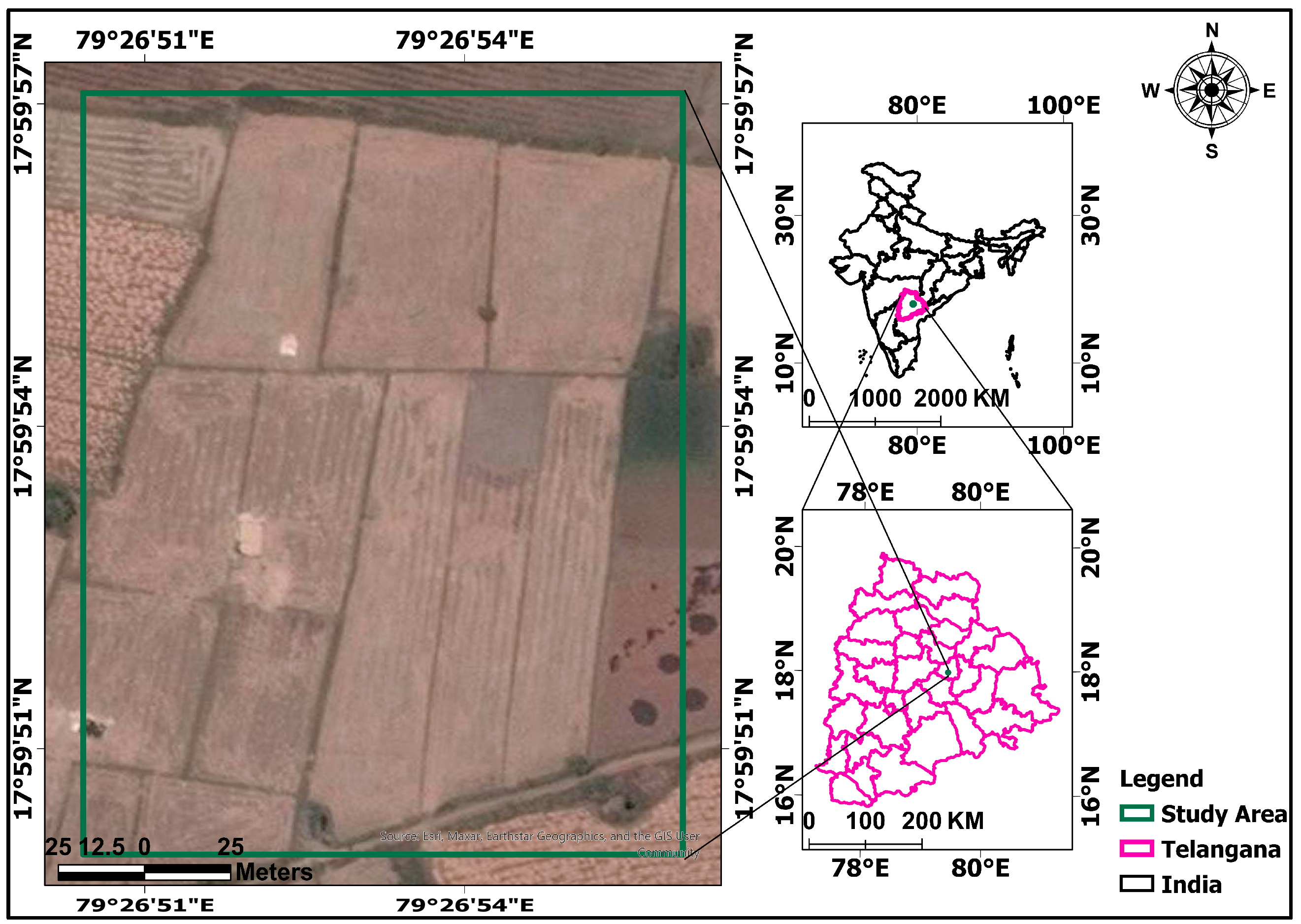
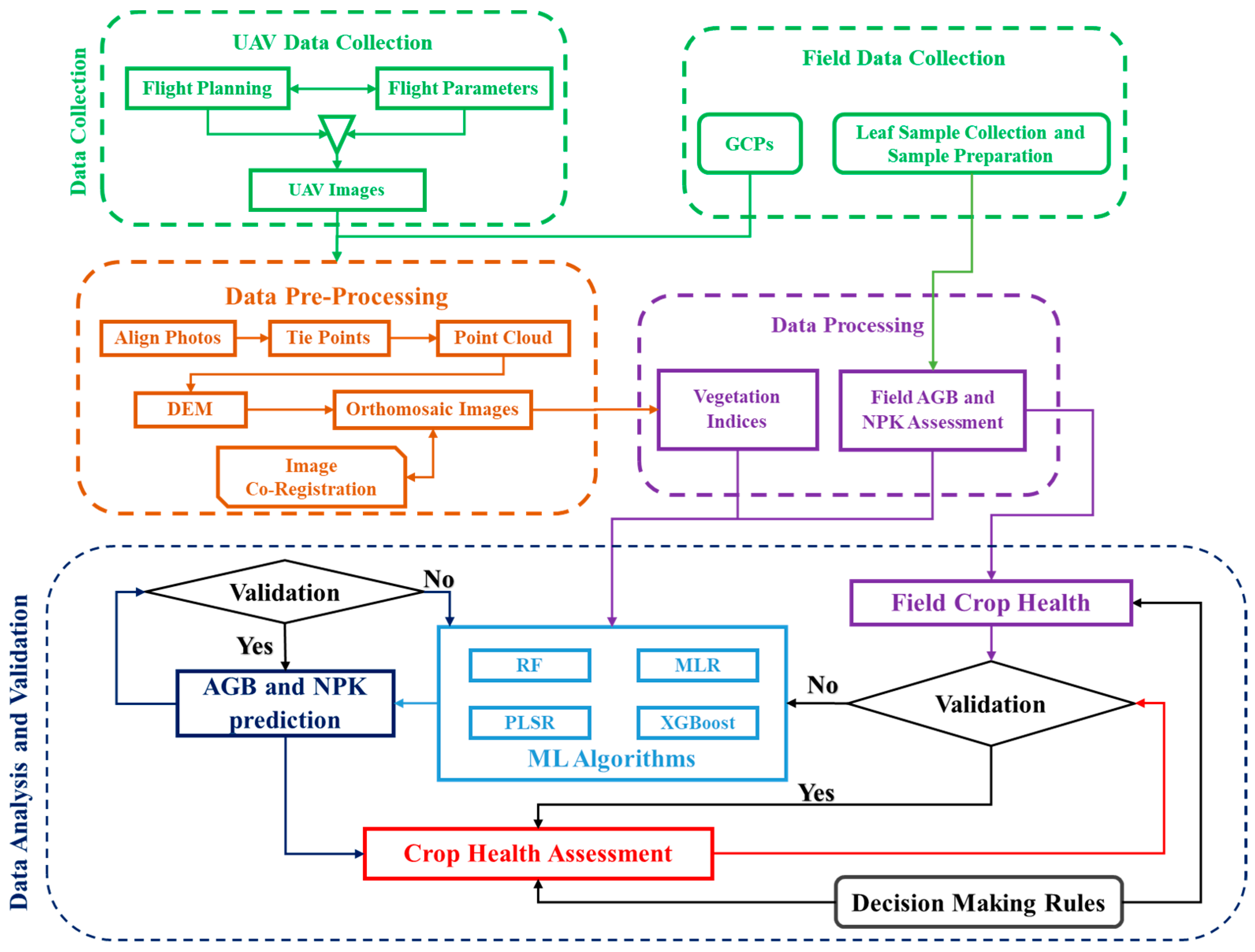

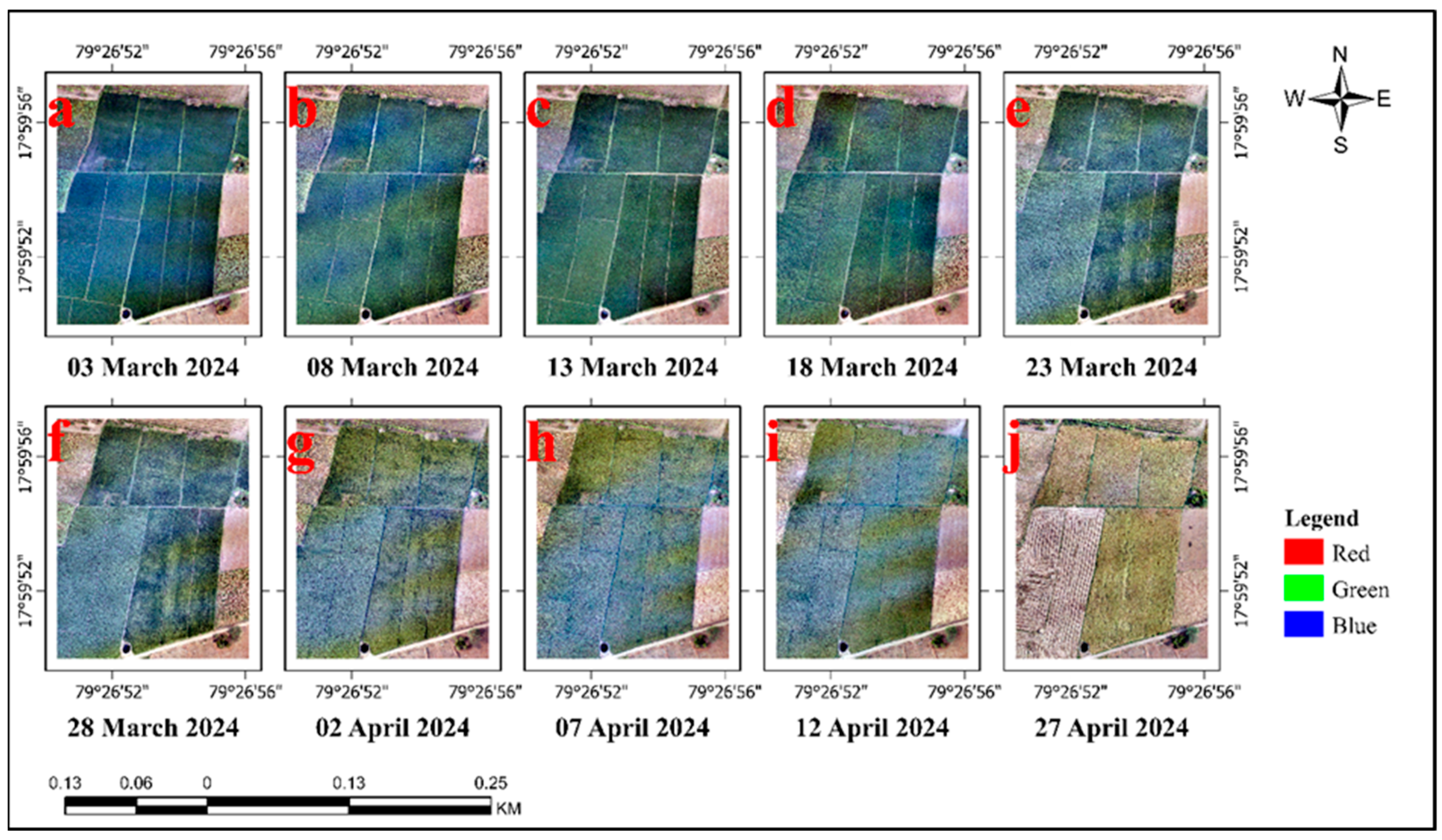

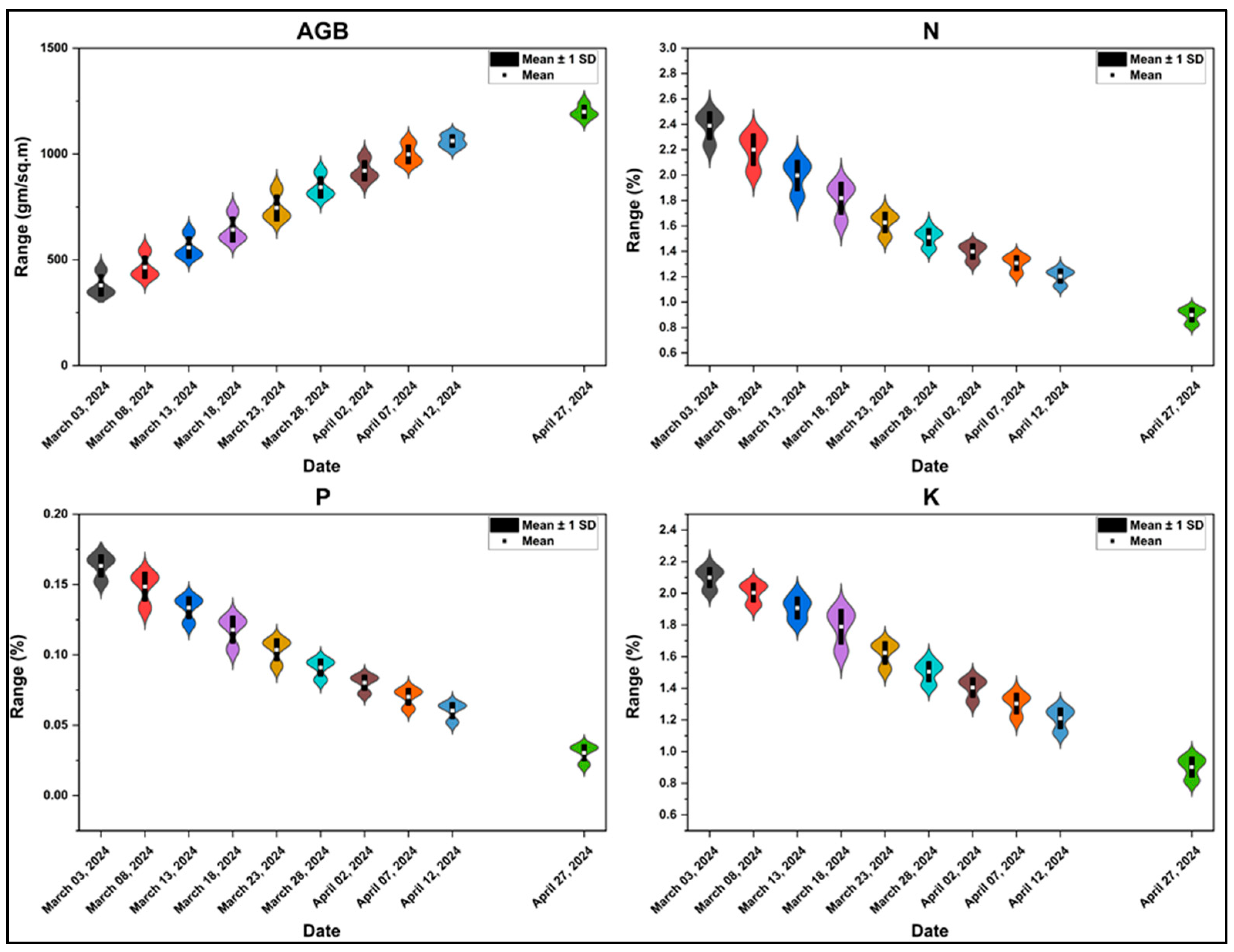
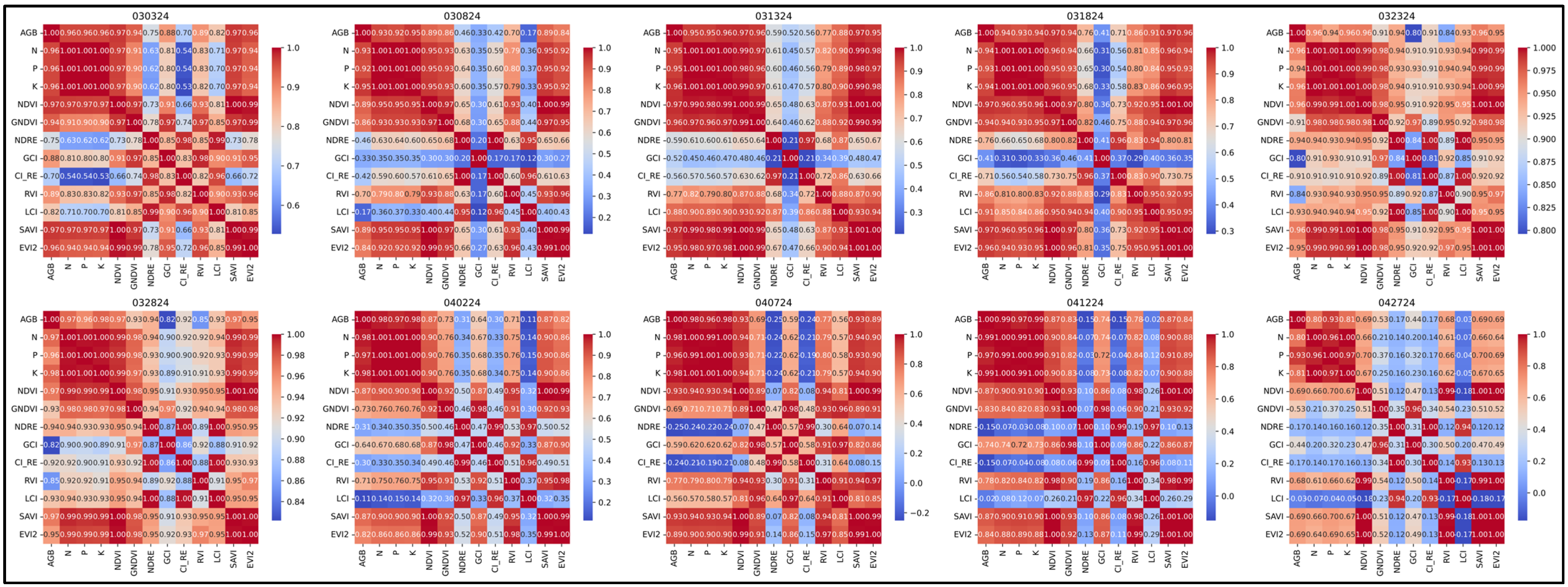
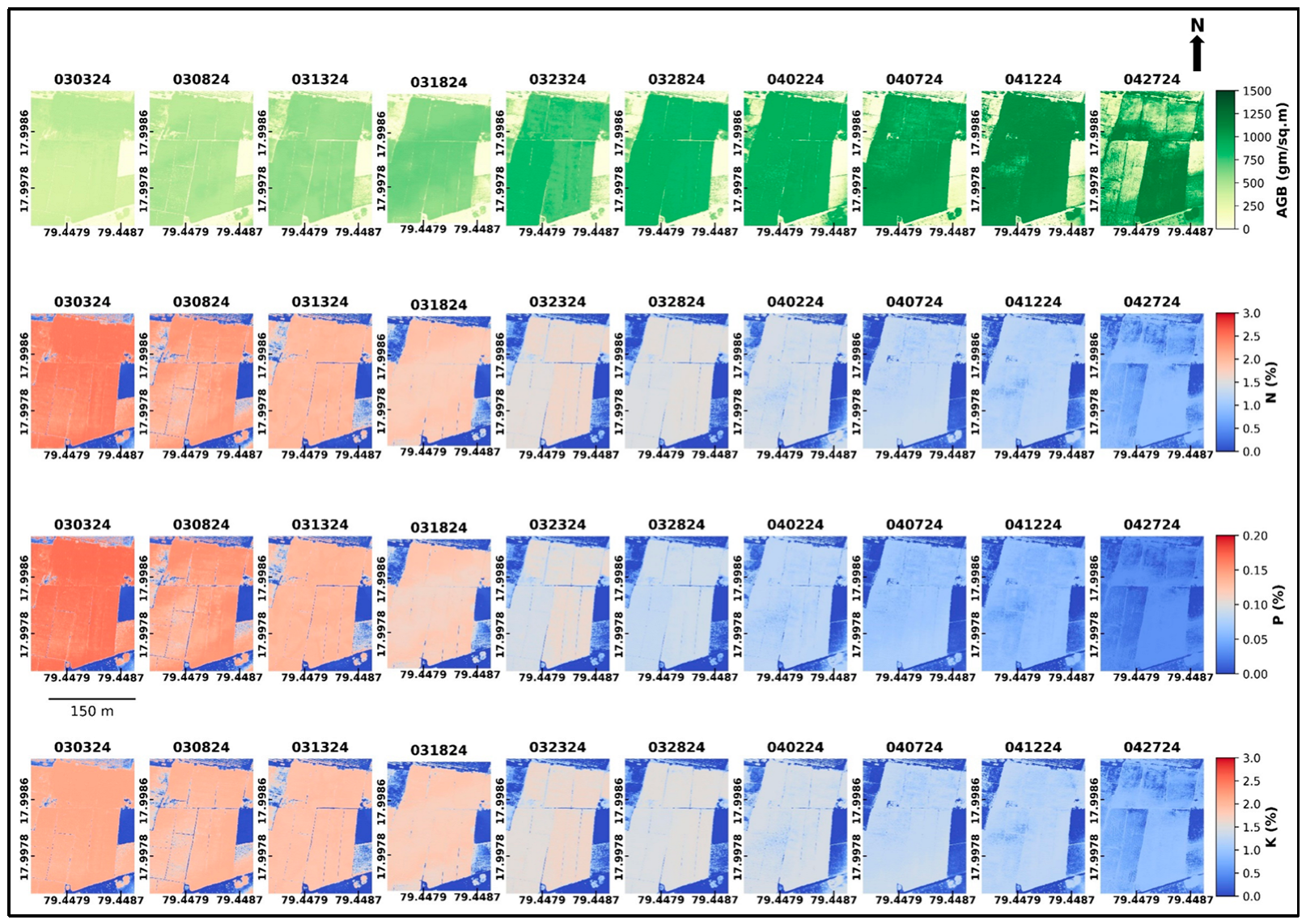
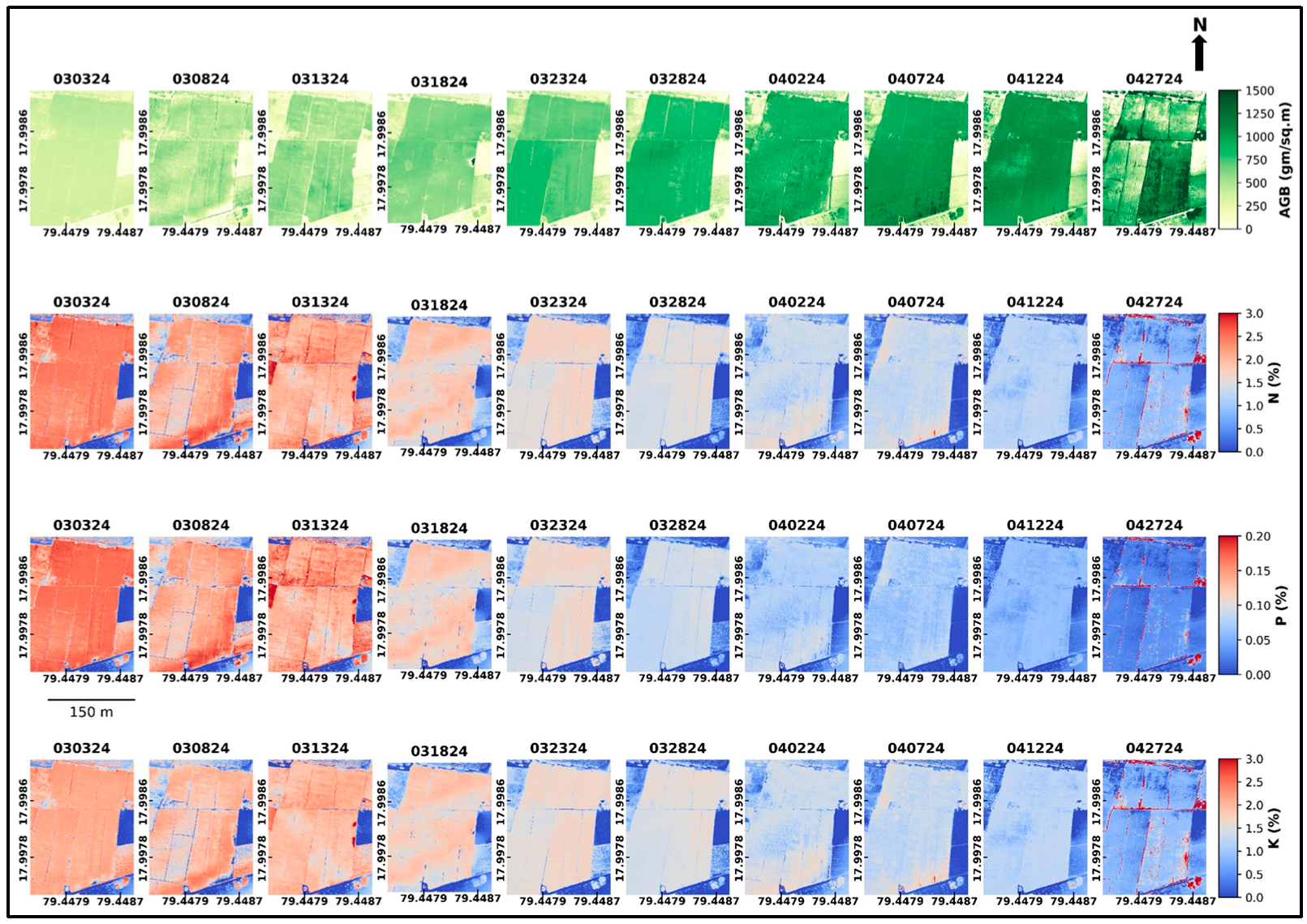
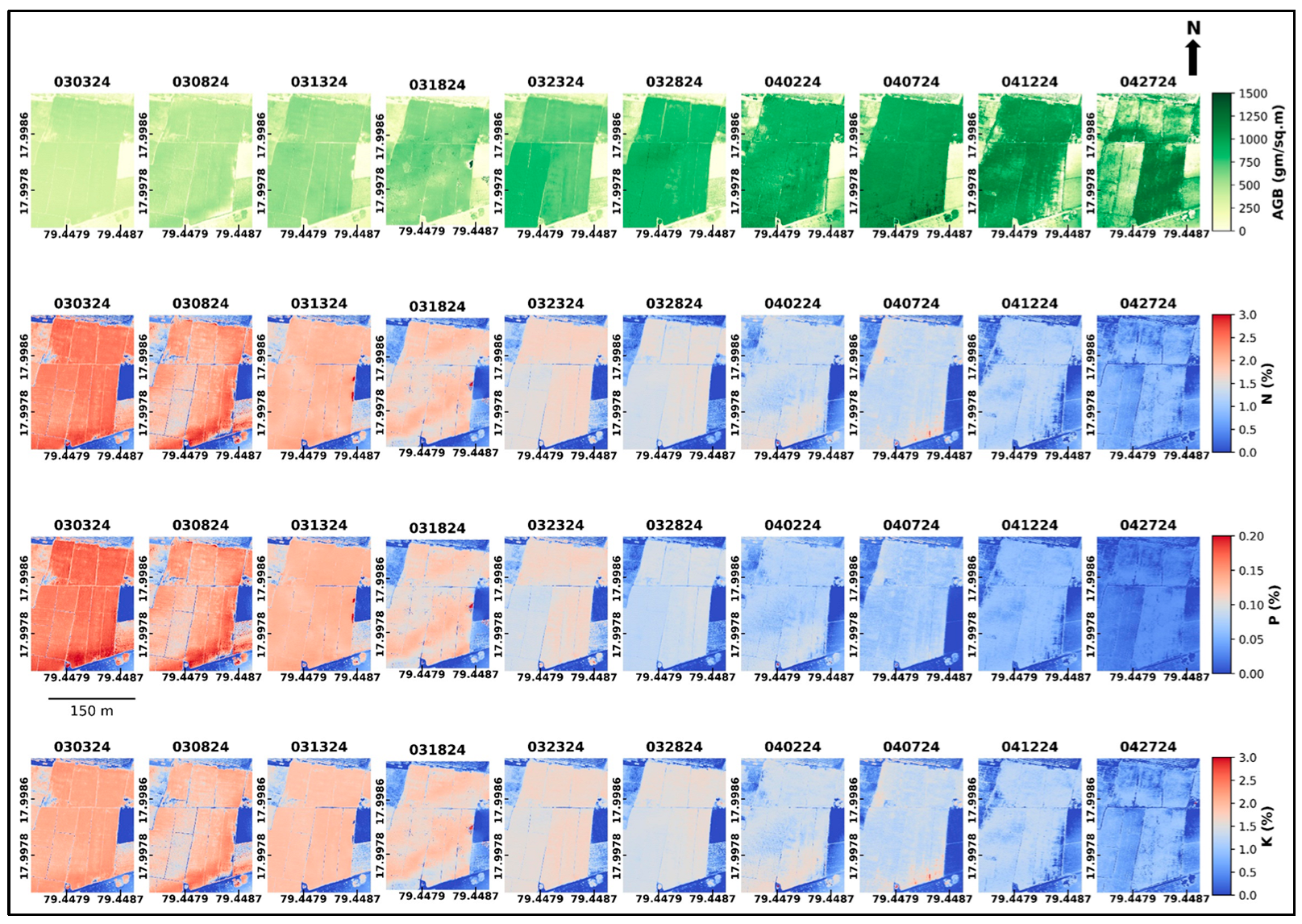
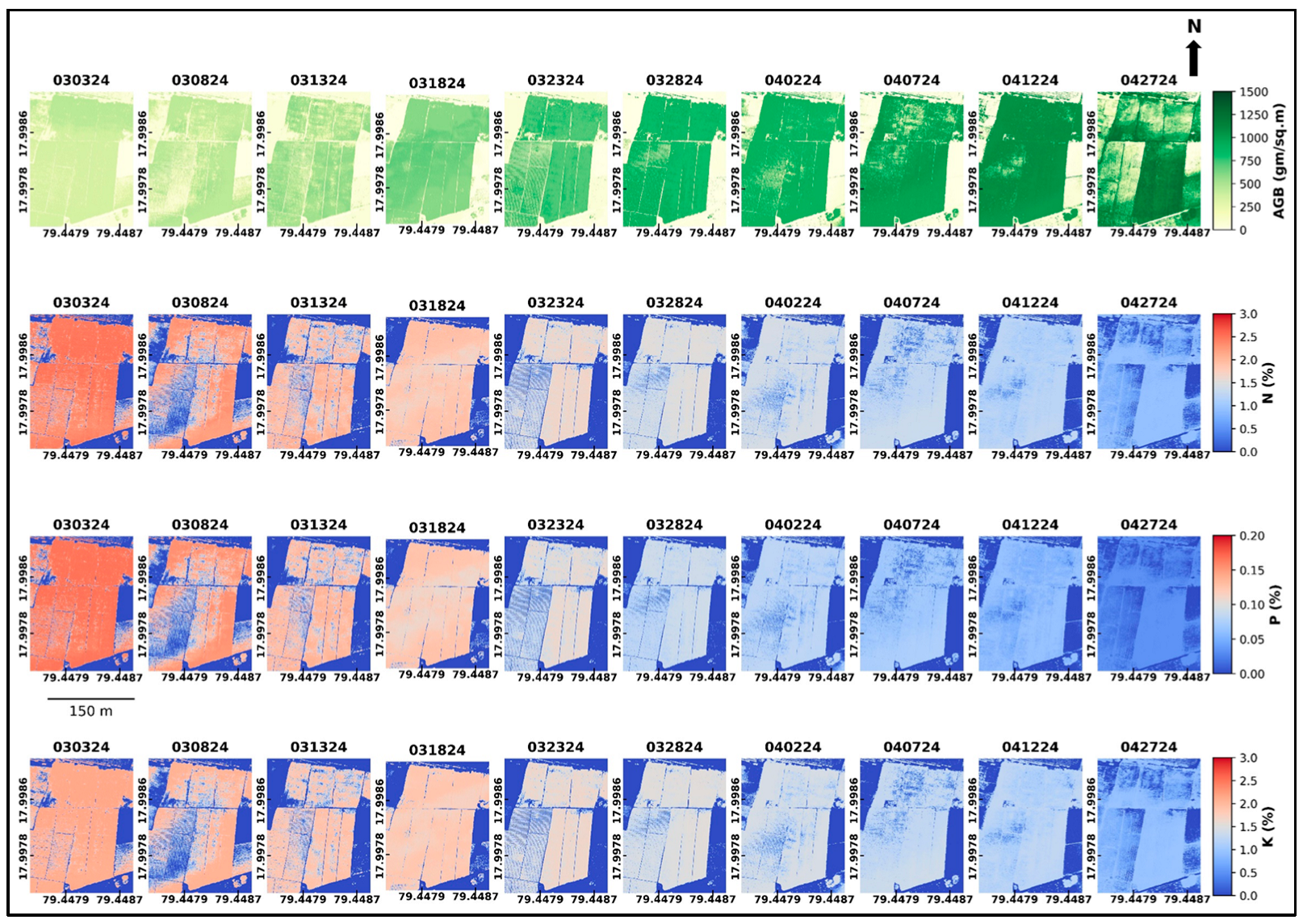

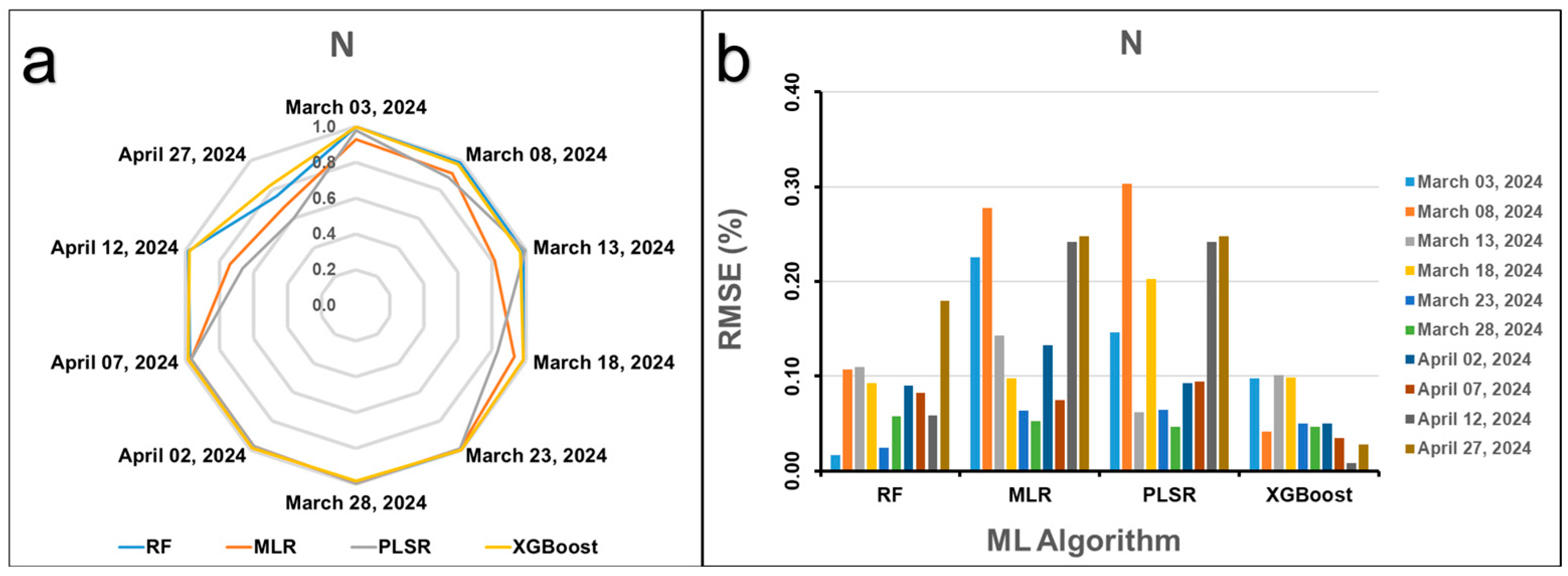
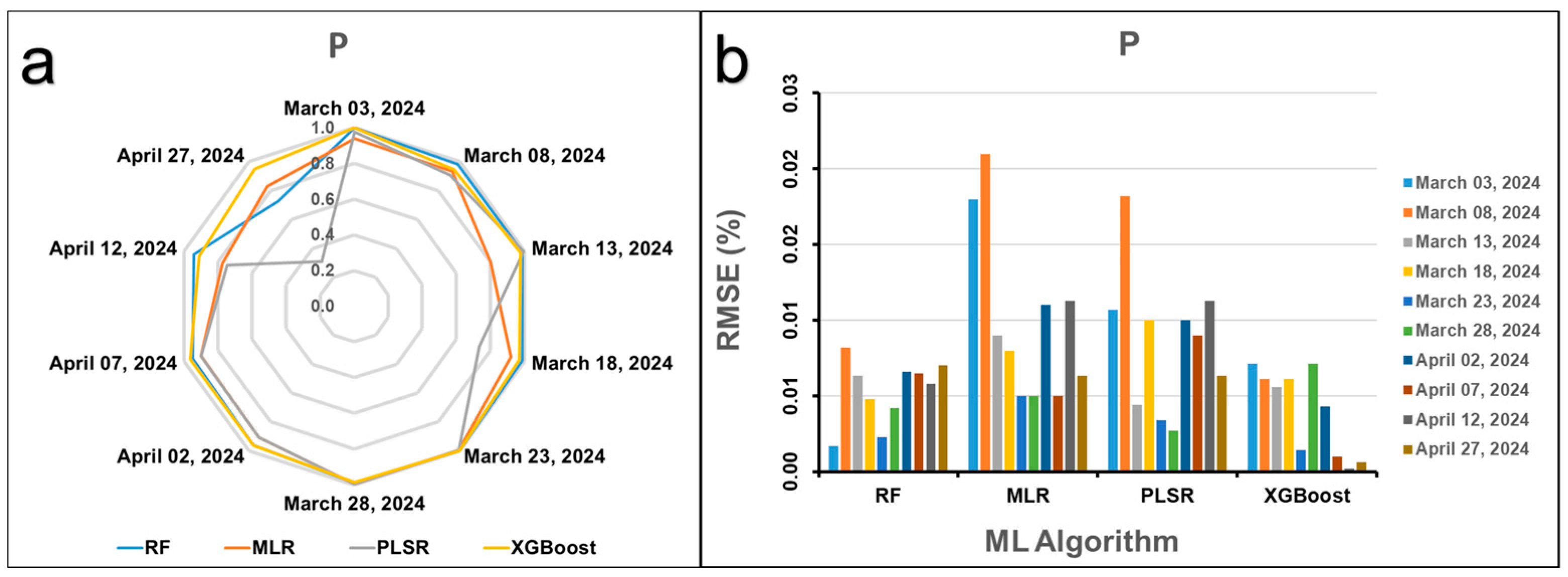
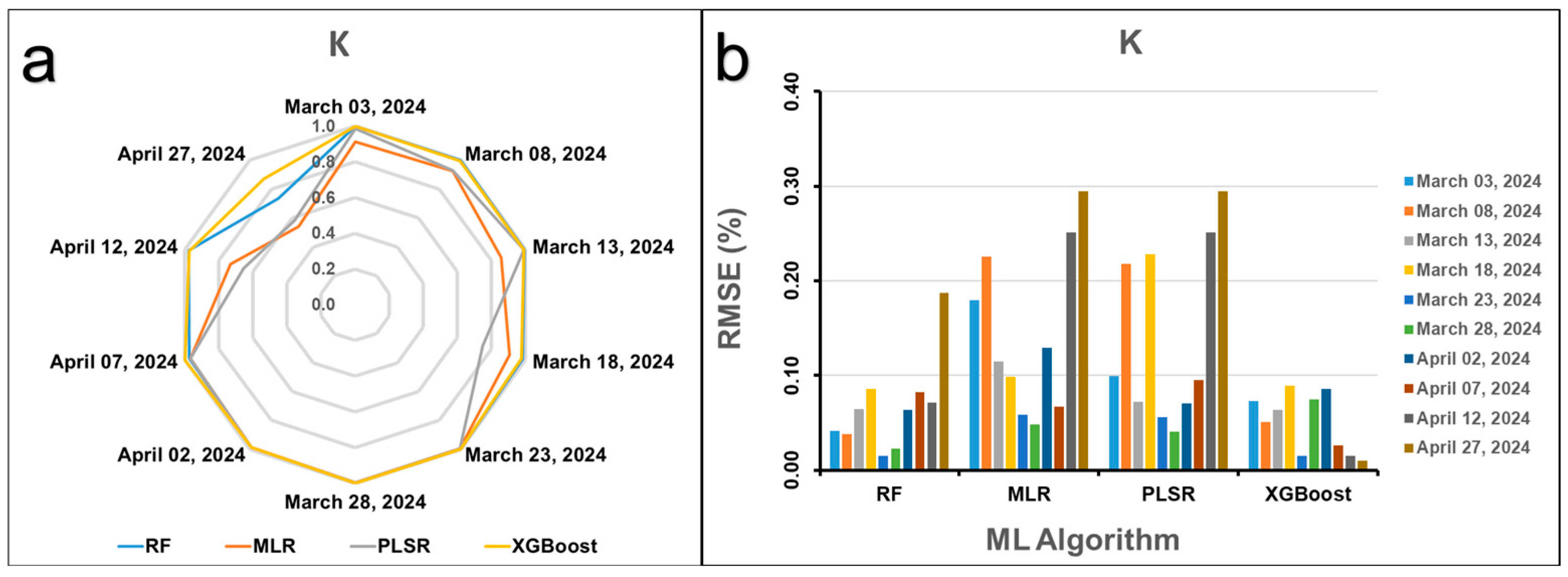
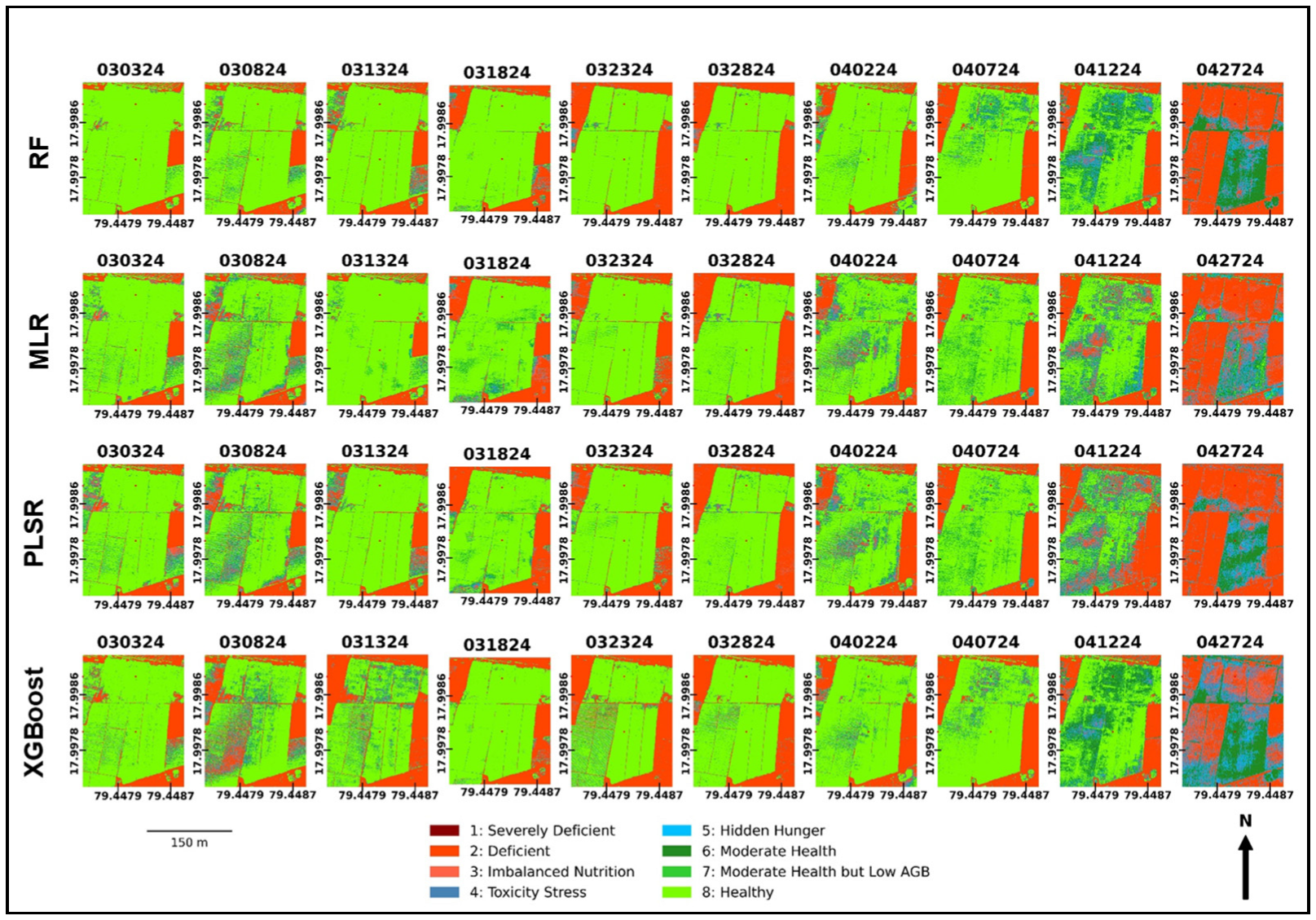
| Date of UAV Data Collection | Days After Sowing (DAS) | Crop Growth Stage | No. of Images Captured in Each Band |
|---|---|---|---|
| 3 March 2024 (030324) | 53 | Panicle Initiation | 573 |
| 8 March 2024 (030824) | 58 | Panicle Initiation | 571 |
| 13 March 2024 (031324) | 63 | Booting | 546 |
| 18 March 2024 (031824) | 68 | Booting | 543 |
| 23 March 2024 (032324) | 73 | Flowering | 591 |
| 28 March 2024 (032824) | 78 | Flowering | 583 |
| 2 April 2024 (040224) | 83 | Grain Filling | 583 |
| 7 April 2024 (040724) | 88 | Grain Filling | 604 |
| 12 April 2024 (041224) | 93 | Maturity | 601 |
| 27 April 2024 (042724) | 108 | Maturity | 477 |
| Index | Formula | Value Range | Application in Agriculture | References |
|---|---|---|---|---|
| Normalized Difference Vegetation Index (NDVI) | −1 to +1 | Assessing vegetation health, detecting drought stress, and monitoring crop growth. | [5] | |
| Green Normalized Difference Vegetation Index (GNDVI) | −1 to +1 | Similar to NDVI but focused on green wavelengths. It is useful for identifying early crop stress before visible symptoms appear. | [26] | |
| Normalized Difference Red Edge Index (NDRE) | −1 to +1 | NDRE is used for monitoring chlorophyll content and plant stress, especially in later growth stages. | [27] | |
| Green Chlorophyll Index (GCI) | −1 to +5 | Used to quantify chlorophyll content in plants, which is essential for assessing crop health. | [18] | |
| Red Edge Chlorophyll Index (CI_RE) | −1 to +4 | Useful in determining chlorophyll content, especially in crops with dense canopies. | [28] | |
| Ratio Vegetation Index (RVI) | 0 to 12 | Used for monitoring vegetation biomass and health. | [29] | |
| Leaf Chlorophyll Index (LCI) | −1 to +1 | Used to estimate chlorophyll content in leaves. | [18] | |
| Soil Adjusted Vegetation Index (SAVI) | −1 to +1 | Used to minimize soil background effects when vegetation is sparse. | [26] | |
| Enhanced Vegetation Index 2 (EVI2) | −1 to +2 | An improved index for assessing vegetation, particularly in areas with dense vegetation. | [15] |
| Mask Value | Category | Description |
|---|---|---|
| 1 | Severely Deficient | Two or more nutrients are in critical state when AGB is lower than threshold |
| 2 | Deficient | Only one nutrient is in critical condition when AGB is lower than threshold |
| 3 | Imbalanced Nutrition | Mixed levels of one or more nutrients in critical state and one nutrient in toxic state |
| 4 | Toxicity Stress | More than one nutrients are in toxic condition |
| 5 | Hidden Hunger | Two or more nutrients are in critical state when the AGB is above the threshold |
| 6 | Moderate Health | Only one nutrient either is in critical or toxic condition when AGB is above the threshold |
| 7 | Moderate Health but Low AGB | All Nutrients are in optimum range but the AGB is lower than threshold |
| 8 | Healthy | All nutrients are in optimum range when AGB is above the threshold |
| Prediction Model | Statistical Parameter | 030324 | 030824 | 031324 | 031824 | 032324 | 032824 | 040224 | 040724 | 041224 | 042724 |
|---|---|---|---|---|---|---|---|---|---|---|---|
| RF | Precision | 1.00 | 0.92 | 1.00 | 1.00 | 0.92 | 0.92 | 0.84 | 0.70 | 0.63 | 0.30 |
| Recall | 0.96 | 0.96 | 1.00 | 0.88 | 0.96 | 0.96 | 0.84 | 0.76 | 0.52 | 0.44 | |
| F1 Score | 0.98 | 0.94 | 1.00 | 0.94 | 0.94 | 0.94 | 0.84 | 0.73 | 0.56 | 0.36 | |
| Kappa | 0.89 | 0.89 | 1.00 | 0.71 | 0.89 | 0.89 | 0.64 | 0.52 | 0.28 | 0.22 | |
| MLR | Precision | 1.00 | 0.91 | 1.00 | 1.00 | 0.92 | 0.96 | 0.84 | 0.79 | 0.58 | 0.27 |
| Recall | 0.92 | 0.76 | 0.92 | 0.88 | 0.88 | 0.88 | 0.76 | 0.72 | 0.40 | 0.44 | |
| F1 Score | 0.96 | 0.83 | 0.96 | 0.94 | 0.90 | 0.92 | 0.79 | 0.75 | 0.43 | 0.33 | |
| Kappa | 0.79 | 0.52 | 0.79 | 0.71 | 0.71 | 0.73 | 0.54 | 0.53 | 0.21 | 0.18 | |
| PLSR | Precision | 1.00 | 0.92 | 1.00 | 0.97 | 0.92 | 0.96 | 0.84 | 0.79 | 0.51 | 0.27 |
| Recall | 0.88 | 0.96 | 1.00 | 0.84 | 0.88 | 0.88 | 0.76 | 0.72 | 0.36 | 0.44 | |
| F1 Score | 0.94 | 0.94 | 1.00 | 0.89 | 0.90 | 0.92 | 0.79 | 0.75 | 0.35 | 0.33 | |
| Kappa | 0.71 | 0.89 | 1.00 | 0.64 | 0.71 | 0.73 | 0.54 | 0.53 | 0.15 | 0.18 | |
| XGBoost | Precision | 1.00 | 0.92 | 1.00 | 1.00 | 0.96 | 0.92 | 0.92 | 0.80 | 0.77 | 0.40 |
| Recall | 1.00 | 0.96 | 1.00 | 1.00 | 0.96 | 0.96 | 0.84 | 0.80 | 0.52 | 0.44 | |
| F1 Score | 1.00 | 0.94 | 1.00 | 1.00 | 0.96 | 0.94 | 0.88 | 0.80 | 0.61 | 0.42 | |
| Kappa | 1.00 | 0.89 | 1.00 | 1.00 | 0.90 | 0.89 | 0.68 | 0.64 | 0.34 | 0.29 |
Disclaimer/Publisher’s Note: The statements, opinions and data contained in all publications are solely those of the individual author(s) and contributor(s) and not of MDPI and/or the editor(s). MDPI and/or the editor(s) disclaim responsibility for any injury to people or property resulting from any ideas, methods, instructions or products referred to in the content. |
© 2025 by the authors. Licensee MDPI, Basel, Switzerland. This article is an open access article distributed under the terms and conditions of the Creative Commons Attribution (CC BY) license (https://creativecommons.org/licenses/by/4.0/).
Share and Cite
Allu, A.R.; Mesapam, S. Crop Health Assessment from Predicted AGB and NPK Derived from UAV Spectral Indices and Machine Learning Techniques. Agronomy 2025, 15, 2059. https://doi.org/10.3390/agronomy15092059
Allu AR, Mesapam S. Crop Health Assessment from Predicted AGB and NPK Derived from UAV Spectral Indices and Machine Learning Techniques. Agronomy. 2025; 15(9):2059. https://doi.org/10.3390/agronomy15092059
Chicago/Turabian StyleAllu, Ayyappa Reddy, and Shashi Mesapam. 2025. "Crop Health Assessment from Predicted AGB and NPK Derived from UAV Spectral Indices and Machine Learning Techniques" Agronomy 15, no. 9: 2059. https://doi.org/10.3390/agronomy15092059
APA StyleAllu, A. R., & Mesapam, S. (2025). Crop Health Assessment from Predicted AGB and NPK Derived from UAV Spectral Indices and Machine Learning Techniques. Agronomy, 15(9), 2059. https://doi.org/10.3390/agronomy15092059






